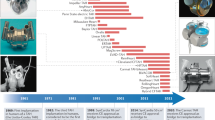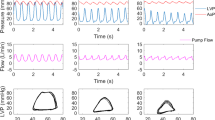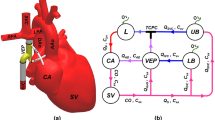Abstract
A practical artificial heart has been sought for >50 years. An increasing number of people succumb to heart disease each year, but the number of hearts available for transplantation remains small. Early total artificial hearts mimicked the pumping action of the native heart. These positive-displacement pumps could provide adequate haemodynamic support and maintain the human circulation for short periods, but large size and limited durability adversely affected recipients' quality of life. Subsequent research into left ventricular assist devices led to the use of continuous-flow blood pumps with rotating impellers. Researchers have attempted to integrate this technology into modern total artificial hearts with moderate clinical success. The importance of pulsatile circulation remains unclear. Future research is, therefore, needed into positive-displacement and rotary total artificial hearts.
This is a preview of subscription content, access via your institution
Access options
Subscribe to this journal
Receive 12 print issues and online access
$209.00 per year
only $17.42 per issue
Buy this article
- Purchase on Springer Link
- Instant access to full article PDF
Prices may be subject to local taxes which are calculated during checkout






Similar content being viewed by others
References
Go, A. S. et al. Heart disease and stroke statistics—2014 update: a report from the American Heart Association. Circulation 129, e28–e292 (2014).
Colvin-Adams, M. et al. OPTN/SRTR 2012 annual data report: heart. Am. J. Transplant. 14 (Suppl. 1), 113–138 (2014).
Akutsu, T. & Kolff, W. J. Permanent substitutes for valves and hearts. ASAIO J. 4, 230–234 (1958).
Cooley, D. A. et al. Orthotopic cardiac prosthesis for two-staged cardiac replacement. Am. J. Cardiol. 24, 723–730 (1969).
Frazier, O. H., Akutsu, T. & Cooley, D. A. Total artificial heart (TAH) utilization in man. ASAIO J. 28, 534–538 (1982).
Kolff, W. J. Artificial organs—forty years and beyond. Trans. Am. Soc. Artif. Intern. Organs 29, 6–24 (1983).
DeVries, W. C. et al. Clinical use of the total artificial heart. N. Engl. J. Med. 310, 273–278 (1984).
Leprince, P. et al. Bridge to transplantation with the Jarvik-7 (CardioWest) total artificial heart: a single-center 15-year experience. J. Heart Lung Transplant. 22, 1296–1303 (2003).
Slepian, M. J. The SynCardia Temporary Total Artificial Heart—evolving clinical role and future status. US Cardiol. 8, 39–46 (2011).
Torregrossa, G. et al. Results with SynCardia total artificial heart beyond 1 year. ASAIO J. 60, 626–634 (2014).
Copeland, J. G. et al. Cardiac replacement with a total artificial heart as a bridge to transplantation. N. Engl. J. Med. 351, 859–867 (2004).
Friedline, K. & Hassinger, P. Total artificial heart freedom driver in a patient with end-stage biventricular heart failure. AANA J. 80, 105–112 (2012).
Johnson, K. E., Prieto, M., Joyce, L. D., Pritzker, M. & Emery, R. W. Summary of the clinical use of the Symbion total artificial heart: a registry report. J. Heart Lung Transplant. 11, 103–116 (1992).
Massiello, A. et al. The Cleveland Clinic-Nimbus total artificial heart. J. Thorac. Cardiovasc. Surg. 108, 412–419 (1994).
Tatsumi, E. et al. In vivo evaluation of the National Cardiovascular Center electrohydraulic total artificial heart. Artif. Organs 23, 242–248 (1999).
Vasku, J. et al. 150-day survival of a calf with a polymethylmethacrylate total artificial heart: TNS-BRNO-II. Artif. Organs 5, 388–400 (1981).
Vasku, J. & Urbanek, P. Constructional and functional characteristics of recent total artificial heart models TNS Brno VII, VIII, and IX. Artif. Organs 19, 535–543 (1995).
Rosenberg, G. et al. A roller screw drive for implantable blood pumps. Trans. Am. Soc. Artif. Intern. Organs 28, 123–126 (1982).
Snyder, A. J. et al. An electrically powered total artificial heart: over 1 year survival in the calf. ASAIO J. 38, M707–M712 (1992).
Weiss, W. J. et al. Steady state hemodynamic and energetic characterization of the Penn State/3M Health Care Total Artificial Heart. ASAIO J. 45, 189–193 (1999).
Snyder, A. J. et al. In vivo testing of a completely implanted total artificial heart system. ASAIO J. 39, M177–M184 (1993).
Harasaki, H. et al. Progress in Cleveland Clinic-Nimbus total artificial heart development. ASAIO J. 40, M494–M498 (1994).
Kung, R. T. V. et al. Progress in the development of the ABIOMED Total Artificial Heart. ASAIO J. 41, M245–M248 (1995).
Kung, R. T. V., Yu, L.-S., Ochs, B. & Frazier, O. H. An atrial hydraulic shunt in a total artificial heart: a balance mechanism for the bronchial shunt. ASAIO J. 39, M213–M217 (1993).
Dowling, R. D. et al. Initial experience with the AbioCor implantable replacement heart system. J. Thorac. Cardiovasc. Surg. 127, 131–141 (2004).
Nose, Y. FDA approval of totally implantable permanent total artificial heart for humanitarian use. Artif. Organs 31, 1–3 (2007).
Frazier, O. H. et al. Multicenter clinical evaluation of the HeartMate 1000 IP left ventricular assist device. Ann. Thorac. Surg. 53, 1080–1090 (1992).
Frazier, O. H. Chronic left ventricular support with a vented electric assist device. Ann. Thorac. Surg. 55, 273–275 (1993).
Rose, E. et al. The REMATCH trial: rationale, design and end points: Randomized Evaluation of Mechanical Assistance for the Treatment of Congestive Heart Failure. Ann. Thorac. Surg. 67, 723–730 (1999).
Frazier, O. H. et al. Initial clinical experience with the Jarvik 2000 implantable axial-flow left ventricular assist system. Circulation 105, 2855–2860 (2002).
Wampler, R. K., Moise, J. C., Frazier, O. H. & Olsen, D. B. In vivo evaluation of a peripheral vascular access axial flow blood pump. ASAIO Trans. 34, 450–454 (1988).
Frazier, O. H. et al. First human use of the Hemopump, a catheter-mounted ventricular assist device. Ann. Thorac. Surg. 49, 299–304 (1990).
Frazier, O. H. & Leon, P. J. Small pumps for ventricular assistance: progress in mechanical circulatory support. Cardiol. Clin. 25, 553–564 (2007).
Frazier, O. H. et al. First clinical use of the redesigned HeartMate II Left Ventricular Assist System in the United States. Tex. Heart Inst. J. 31, 157–159 (2004).
Kirklin, J. K. et al. Interagency Registry for Mechanically Assisted Circulatory Support (INTERMACS) analysis of pump thrombosis in the HeartMate II left ventricular assist device. J. Heart Lung Transplant. 33, 12–22 (2014).
Salamonsen, R. F., Mason, D. G. & Ayre, P. J. Response of rotary blood pumps to changes in preload and afterload at a fixed speed setting are unphysiological when compared with the natural heart. Artif. Organs 35, E47–E53 (2011).
Golding, L. R. et al. Chronic nonpulsatile blood flow in an alive, awake animal 34-day survival. Trans. Am. Soc. Artif. Intern. Organs 26, 251–255 (1980).
Qian, K. X., Pi, K. D., Wang, Y. P. & Zhao, M. J. Toward an implantable impeller total heart. ASAIO Trans. 33, 704–707 (1987).
Slaughter, M. S. et al. Advanced heart failure treated with continuous-flow left ventricular assist device. N. Engl. J. Med. 361, 2241–2251 (2009).
Frazier, O. H., Tuzun, E., Cohn, W., Tamez, D. & Kadipasaoglu, K. A. Total heart replacement with dual centrifugal ventricular assist devices. ASAIO J. 51, 224–229 (2005).
Frazier, O. H., Tuzun, E., Cohn, W. E., Conger, J. L. & Kadipasaoglu, K. A. Total heart replacement using dual intracorporeal continuous-flow pumps in a chronic bovine model: a feasibility study. ASAIO J. 52, 145–149 (2006).
Cohn, W. E. et al. Eight-year experience with a continuous-flow total artificial heart in calves. ASAIO J. 60, 25–30 (2014).
Frazier, O. H., Cohn, W. E., Tuzun, E., Winkler, J. A. & Gregoric, I. D. Continuous-flow total artificial heart supports long-term survival of a calf. Tex. Heart Inst. J. 36, 568–574 (2009).
Frazier, O. H., Khalil, H. A., Benkowski, R. J. & Cohn, W. E. Optimization of axial-pump pressure sensitivity for a continuous-flow total artificial heart. J. Heart Lung Transplant. 29, 687–691 (2010).
Khalil, H. A. et al. Continuous flow total artificial heart: modeling and feedback control in a mock circulatory system. ASAIO J. 54, 249–255 (2008).
Frazier, O. H. & Cohn, W. Continuous-flow total heart replacement device implanted in a 55-year-old man with end-stage heart failure and severe amyloidosis. Tex. Heart Inst. J. 39, 542–546 (2012).
Pirk, J. et al. Total artificial heart support with two continuous-flow ventricular assist devices in a patient with an infiltrating cardiac sarcoma. ASAIO J. 59, 178–180 (2013).
Netuka, I. et al. Novel treatment of an infiltrating cardiac fibrosarcoma. Tex. Heart Inst. J. 41, 248–249 (2014).
Strueber, M., Schmitto, J. D., Kutschka, I. & Haverich, A. Placement of 2 implantable centrifugal pumps to serve as a total artificial heart after cardiectomy. J. Thorac. Cardiovasc. Surg. 143, 507–509 (2012).
Timms, D. et al. The BiVACOR rotary biventricular assist device: concept and in vitro investigation. Artif. Organs 32, 816–819 (2008).
Fukamachi, K. et al. An innovative, sensorless, pulsatile, continuous-flow total artificial heart: device design and initial in-vitro study. J. Heart Lung Transplant. 29, 13–20 (2010).
Fumoto, H. et al. In vivo acute performance of the Cleveland Clinic self-regulating, continuous-flow total artificial heart. J. Heart Lung Transplant. 29, 21–26 (2010).
Karimov, J. H. et al. In vivo evaluation of the Cleveland Clinic continuous-flow total artificial heart in calves [abstract]. J. Heart Lung Transplant. 33 (Suppl.), S165–S166 (2014).
Greatrex, N., Timms, D., Kurita, N., Palmer, E. & Masuzawa, T. Axial magnetic bearing development for the BiVACOR Rotary BiVAD/TAH. IEEE Trans. Biomed. Eng. 57, 714–721 (2010).
Timms, D., Kurita, N., Greatrex, N. & Masuzawa, T. BiVACOR—a magnetically levitated biventricular artificial heart [abstract]. Presented at the 20th MAGDA Conference.
Timms, D. et al. Initial acute in-vivo animal experience with the BiVACOR Rotary Bi-Ventricular Assist Device [abstract]. Artif. Organs 31, A67 (2007).
Ryan, T. D., Jefferies, J. L., Zafar, F., Lorts, A. & Morales, D. L. S. The evolving role of the total artificial heart in the management of end-stage congenital heart disease and adolescents. ASAIO J. 61, 8–14 (2015).
Jarvik, R., Westaby, S., Katsumata, T., Pigott, D. & Evans, R. D. LVAD power delivery: a percutaneous approach to avoid infection. Ann. Thorac. Surg. 65, 470–473 (1998).
Fritschi, A. et al. Image based evaluation of mediastinal constraints for the development of a pulsatile total artificial heart. BioMed. Eng. OnLine 12, 81 (2013).
Pohlmann, A. et al. Experimental validation of the linear drive train for a total artificial heart system. Mechatronics 23, 222–226 (2013).
Laumen, M. et al. A novel total artificial heart for destination therapy: in-vitro and in-vivo study. Biomed. Tech. http://dx.doi.org/10.1515/bmt-2013-4373.
Author information
Authors and Affiliations
Contributions
W.E.C. and D.L.T. researched data for the article. All the authors discussed the content of the article, wrote the manuscript, and reviewed drafts before submission.
Corresponding author
Ethics declarations
Competing interests
D.L.T. is the founder of BiVACOR, Inc. The other authors declare no competing interests.
Rights and permissions
About this article
Cite this article
Cohn, W., Timms, D. & Frazier, O. Total artificial hearts: past, present, and future. Nat Rev Cardiol 12, 609–617 (2015). https://doi.org/10.1038/nrcardio.2015.79
Published:
Issue Date:
DOI: https://doi.org/10.1038/nrcardio.2015.79
This article is cited by
-
The ongoing quest for the first total artificial heart as destination therapy
Nature Reviews Cardiology (2022)
-
Cardioprotective effect of silicon-built restraint device (ASD), for left ventricular remodeling in rat heart failure model
Journal of Materials Science: Materials in Medicine (2022)
-
Experimental and numerical investigation of different geometrical parameters in a centrifugal blood pump
Research on Biomedical Engineering (2022)
-
A perfusable, multifunctional epicardial device improves cardiac function and tissue repair
Nature Medicine (2021)



